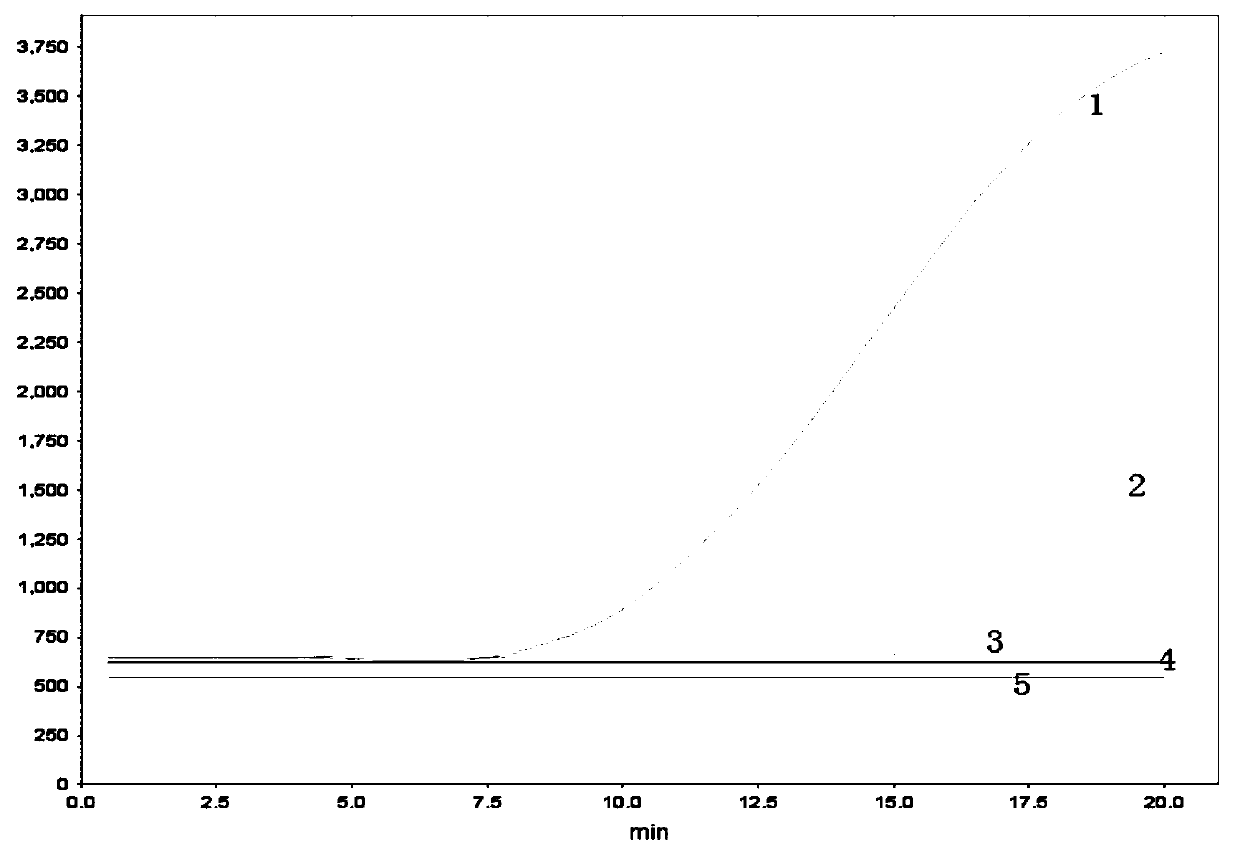Specific primer pair, probe and detection reagent kit for detecting aeromonas hydrophila
A technology of Aeromonas hydrophila and detection kits, applied in the field of probes, kits, and primers, which can solve the problems of limiting the use of LAMP methods and false positive results
- Summary
- Abstract
- Description
- Claims
- Application Information
AI Technical Summary
Problems solved by technology
Method used
Image
Examples
Embodiment 1
[0064] 1. Acquisition of the positive plasmid of Aeromonas hydrophila: through the NCBI search literature, the common Aeromonas hydrophila genes are listed, and the Vector NTI software is used to compare and find out its conserved region, and select the partial region of the aerA gene as The target amplified segment was constructed into the vector PUC57 to prepare a positive plasmid for Aeromonas hydrophila. The plasmid was synthesized by Sangon Bioengineering (Shanghai) Co., Ltd. The partial sequence of the selected aerA gene is as follows:
[0065] GGGTATCGTTGTGGCGAGAAGACGGCCATCAAGGTCAGCAACTTTGCATACAACCTGGACCCTGACAGTTTCAAACATGGTGACGTGACCCAGTCTGATCGCCAGCTGGTCAAGACGGTGGTGGGCTGGGCGATCAACGACAGCGACACCCCGCAATCCGGTTATGATGTCACCCTACGTTACGATACTGCCACCAACTGGTCCAAGACCAATACCTATGGCCTGAGCGAGAAGGTGACCACCAAGAACAAGTTCAAGTGGCCACTGGTAGGAGAAACCGAACTCTCCATCGAGATTGCGGCCAACCAGTCCTGGGCATCCCAGAACGGGGGCTCTACCACCACCTCCCTGTCGCAATCCGTGCGGCCAACTGTGCCGGCCCGCTCCAAGATCCCGGTGAAGATCGAGCTCTACAAGGCTGACATCTCCTATCCCT...
Embodiment 2
[0092] Select the following primers and probe sequences:
[0093] The upstream primer sequence is: 5'-CGGTTATGATGTCACCCCTACGTTACGATAC-3' (SEQ ID NO: 3);
[0094] The downstream primer sequence is: 5'-CACGGATTGCGACAGGGAGGTGGTGGTAGA-3' (SEQ ID NO: 4);
[0095] The probe sequence is: 5'-TCACCCTACGTTACGATACTGCCACCAAC(FAM-dT)G(THF)(BHQ1-dT)CCAAGACCAATACCTA(C3-SPACER)-3'(SEQ ID NO: 9)
[0096] By synthesizing a plasmid containing the aerA gene sequence of Aeromonas hydrophila as the detection target, the method version amplification test of recombinase polymerase amplification (combined with exonuclease III) was carried out, and a 50 μl amplification reaction system was constructed as follows:
[0097] 60mM tris-acetic acid buffer pH8.0
[0098] 100mM potassium acetate
[0099] 14mM magnesium acetate
[0100] 3mM Dithiothreitol
[0101] 5% polyethylene glycol (20000)
[0102] 2mM ATP
[0103] 20mM creatine phosphate
[0104] 100ng / μl creatine kinase
[0105] 600ng / μl E. col...
Embodiment 3
[0120] Select the primer pair and probe sequence designed in Example 2, utilize the recombinase polymerase amplification (in conjunction with endonuclease IV) method amplification reaction system to amplify, construct 50 μ l amplification reaction system as follows:
[0121] 60mM tris-acetic acid buffer pH8.0
[0122] 100mM potassium acetate
[0123] 14mM magnesium acetate
[0124] 3mM Dithiothreitol
[0125] 5% polyethylene glycol (molecular weight 20000)
[0126] 2mM ATP
[0127] 20mM creatine phosphate
[0128] 100ng / μl creatine kinase
[0129] 400ng / μl E. coli recA protein
[0130] 200ng / μl E. coli SSB protein
[0131] 60ng / μl E. coli recO protein
[0132] 40ng / μl E. coli recR protein
[0133] 60ng / μl E. coli recF protein
[0134] 8Units Bacillus subtilis DNA polymerase I
[0135] 50ng / μl Endonuclease IV
[0136] 450 μM dNTPs
[0137] 420nM per upstream primer
[0138] 420nM each downstream primer
[0139] 120nM fluorescent probe
[0140] The template is a ...
PUM
 Login to View More
Login to View More Abstract
Description
Claims
Application Information
 Login to View More
Login to View More - R&D Engineer
- R&D Manager
- IP Professional
- Industry Leading Data Capabilities
- Powerful AI technology
- Patent DNA Extraction
Browse by: Latest US Patents, China's latest patents, Technical Efficacy Thesaurus, Application Domain, Technology Topic, Popular Technical Reports.
© 2024 PatSnap. All rights reserved.Legal|Privacy policy|Modern Slavery Act Transparency Statement|Sitemap|About US| Contact US: help@patsnap.com










